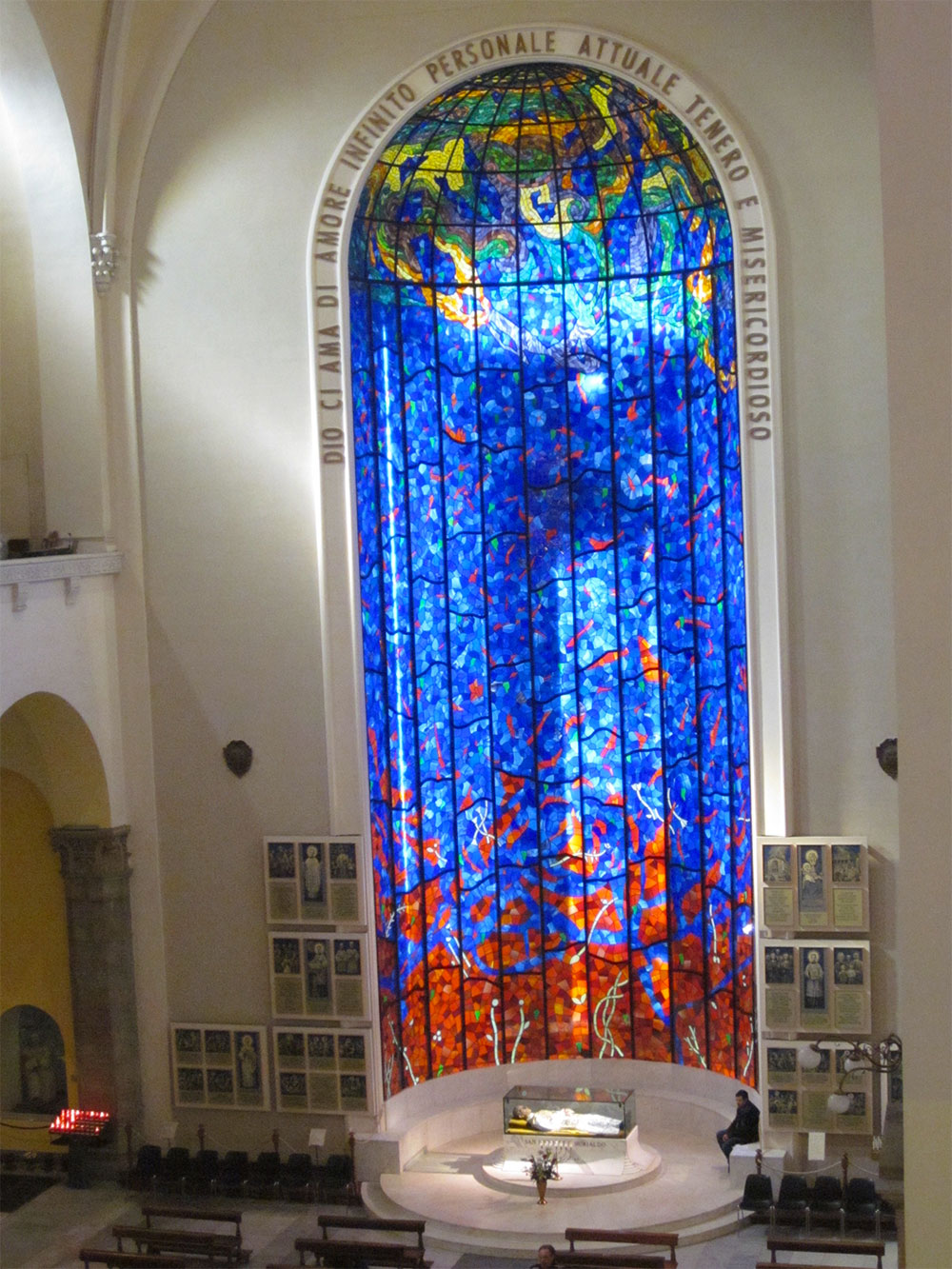THE PLACES
ST. LEONARD MURIALDO
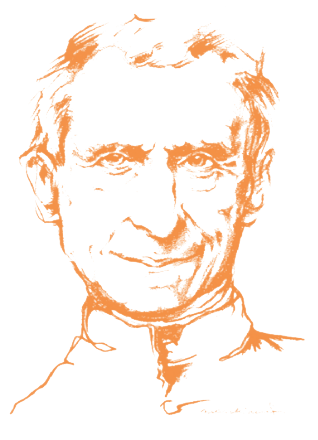
Places
St. Leonard
- Collegio degli Artigianelli
- Chiesa di Santa Barbara
- Casa Natale del Murialdo
- Chiesa di San Dalmazzo
- Chiesa di Santa Chiara
- Santuario della Consolata
- Chiesa della Visitazione
- Oratorio San Luigi
- Villa Murialdo
- Università
- Casa famiglia per giovani operai e per studenti
- Tomba della Famiglia Murialdo
- Chiesa di Nostra Signora della Salute
- Oratorio San Martino
The Artigianelli Boarding School
- Corso Palestro, 14 – Torino
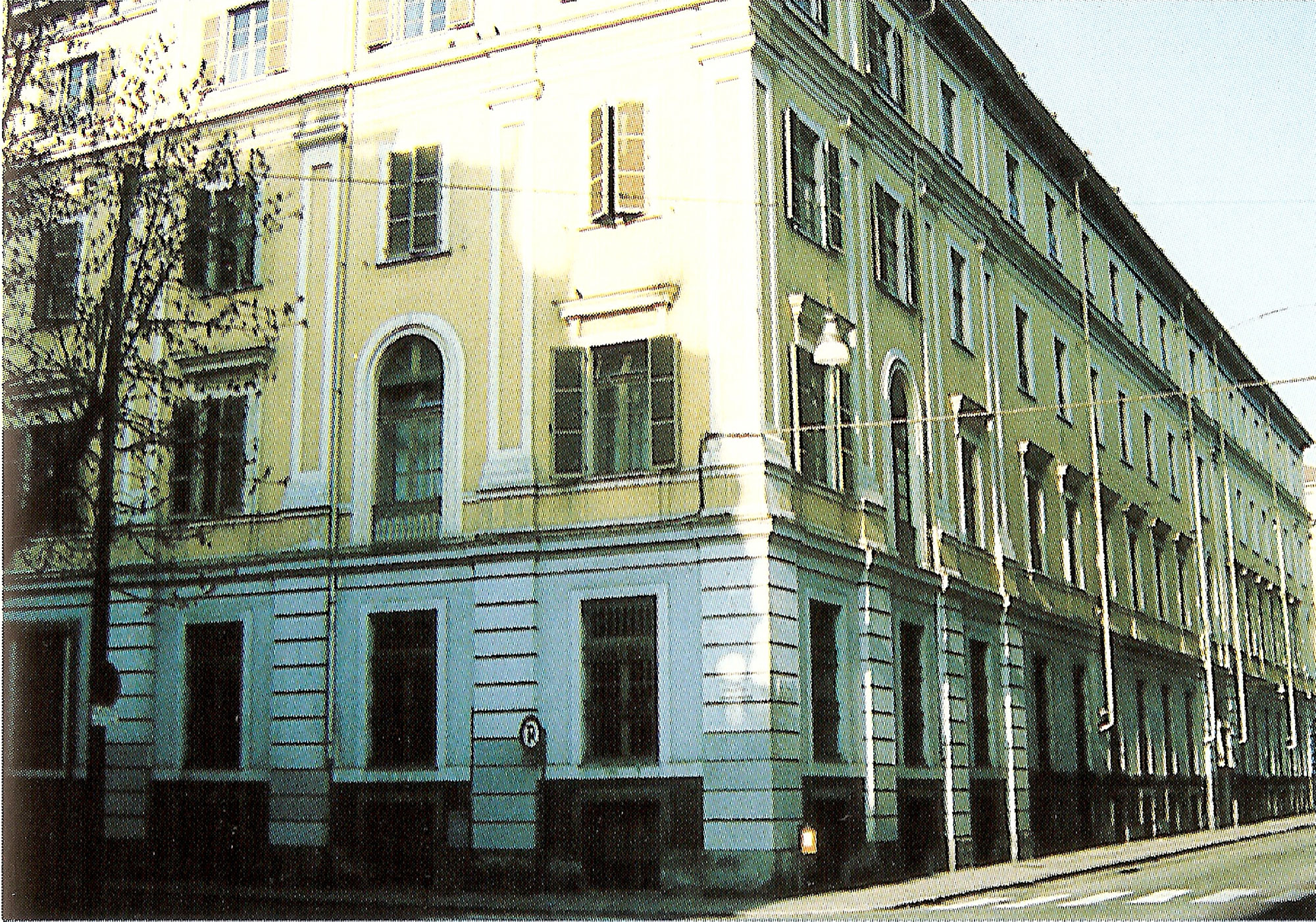
Il Collegio Artigianelli di Torino fu fondato da don Giovanni Cocchi (1813-1895) il quale, alla fine del 1849 cominciò a radunare attorno a sé alcuni ragazzi poveri e abbandonati. Il collegio subì vari traslochi, fino al trasferimento (marzo 1863) nella sua sede definitiva, appositamente costruita, in Corso Palestro 14, quando ormai ne era rettore don Pier Giuseppe Berizzi (1824-1873).
Il nome “Artigianelli”, voluto da don Cocchi, alludeva alla formazione professionale che l’istituto assicurava ai suoi giovani, mediante vari laboratori (per i falegnami, i calzolai, i sarti, i tipografi, i legatoria di libri, i fabbri, gli scultori e i pittori, i tornitori in ferro).
Nel 1866 Berizzi fu richiamato nella sua diocesi di origine (Biella) e il Murialdo lo sostituì nella direzione, facendosi carico di quei ragazzi poveri e abbandonati che negli anni del suo rettorato furono sempre circa 180-200.
Il Collegio Artigianelli ha per i Giuseppini e per tutta la Famiglia del Murialdo un valore unico ed inestimabile perché qui è vissuto il Murialdo per 33 anni e qui egli ha fondato la Congregazione di San Giuseppe. E’ la Casa Madre della congregazione, colma dei ricordi di san Leonardo, di don Reffo, di don Costantino e di altri Giuseppini della prima ora.
La visita inizia dall’atrio d’ingresso, nel quale campeggia il busto di don Cocchi, fondatore del collegio. Il porticato che si affaccia sul cortile offre l’idea di come era il collegio al tempo del Murialdo: l’unica ala costruita era quella rivolta verso Corso Palestro. Sugli altri lati del cortile vi erano delle tettoie o altre costruzioni molto dimesse adibite a magazzino e talvolta a laboratorio.
I busti in marmo del Murialdo, di don Reffo e di don Costantino sovrastano l’ingresso al cortile.
Salendo al primo piano, si può visitare la Mostra-Museo sulla vita e la figura di san Leonardo Murialdo, all’interno della quale si conserva la camera del “Rettore”, rimasta sostanzialmente intatta, anche nell’arredo.
Al secondo piano si trova la Cappella di San Giuseppe nella quale il 19 marzo 1873 venne fondata la congregazione.
La cappella, vero cuore della giovane congregazione, fu successivamente ingrandita e impreziosita con opere pittoriche e di intaglio, splendida testimonianza del livello artistico a cui era pervenuta la scuola di pittura, scultura ed ebanisteria del Collegio Artigianelli.
La decorazione fu iniziata dal confratello laico giuseppino Giovanni Massoglia, il quale dipinse gli angeli che sorreggono gli stemmi della congregazione, le vele delle lunette e tutta la decorazione della volta.
Egli però morì prima di terminare l’opera, eseguendo soltanto due lunette, quella di Adamo e quella di Abele. Le altre furono completate da Pietro Favaro nel 1973 in occasione del centenario della congregazione.
L’altare era originariamente sormontato da un quadro di San Giuseppe, in forma ovale, oggi conservato a Roma nella Casa Generalizia dei Giuseppini. L’attuale pala d’altare con San Giuseppe in trono è ugualmente di Reffo: risale al 1892 e fu completata nel 1894.
L’altare è un finissimo lavoro di intaglio e di intarsio, opera di Massoglia e dei suoi allievi. La predella, è un mosaico in fondo di noce, con intarsi di più di trenta qualità di legno pregiato. Tutta l’opera (altare e predella) fu ammirata e premiata all’Esposizione Nazionale di Torino del 1884.
Le artistiche vetrate del pittore Piero Dalle Ceste furono eseguite anch’esse in occasione del centenario della congregazione nel 1973. Rappresentano la fondazione della congregazione, l’apostolato del Murialdo fra i giovani e gli emblemi araldici del Murialdo e della congregazione (in sacrestia).
In quella che oggi è una sacrestia e che ai tempi del Murialdo era il “presbiterio” della prima cappella dell’Immacolata (quella dei ragazzi), è stato ricollocato l’altare al quale tante volte il Murialdo, don Reffo e don Costantino celebrarono messa per i loro ragazzi.
Ritornati al primo piano, si può visitare l’ala su via Juvarra, costruita a partire dal 1910. Vi si trova la cappella dell’Immacolata, progettata dal confratello Giovanni Massoglia. L’altare in marmo, pure del Massoglia, fu inaugurato nel 1916, in occasione del cinquantesimo anniversario di ordinazione sacerdotale di don Reffo. La pala d’altare, rappresentante l’Immacolata, fu dipinta da Enrico Reffo nel 1915.
Ai lati del presbiterio sono collocate le statue del Sacro Cuore e di San Giuseppe, opera dello scultore Anacleto Barbieri, della Scuola Reffo (1929).
In fondo alla chiesa, a sinistra, una colonna sorregge il busto di don Cocchi, fondatore del collegio. Le sue ossa, esumate dal Cimitero Generale di Torino, furono qui collocate il 13 maggio 1917.
Il piano sottostante la cappella dell’Immacolata è occupato dal Teatro, intitolato a don Cocchi e inaugurato nel 1913 in occasione del centenario della sua nascita. La Compagnia Fiaschi vi si produsse in molte rappresentazioni che resero rinomata la tradizione teatrale degli Artigianelli, grazie soprattutto alle commedie e agli atti unici scritti da don Reffo e alle scene dipinte da suo fratello, il pittore Enrico.
The Church of st. Barabara
- Via Assarotti, angolo Via Bertola – Torino
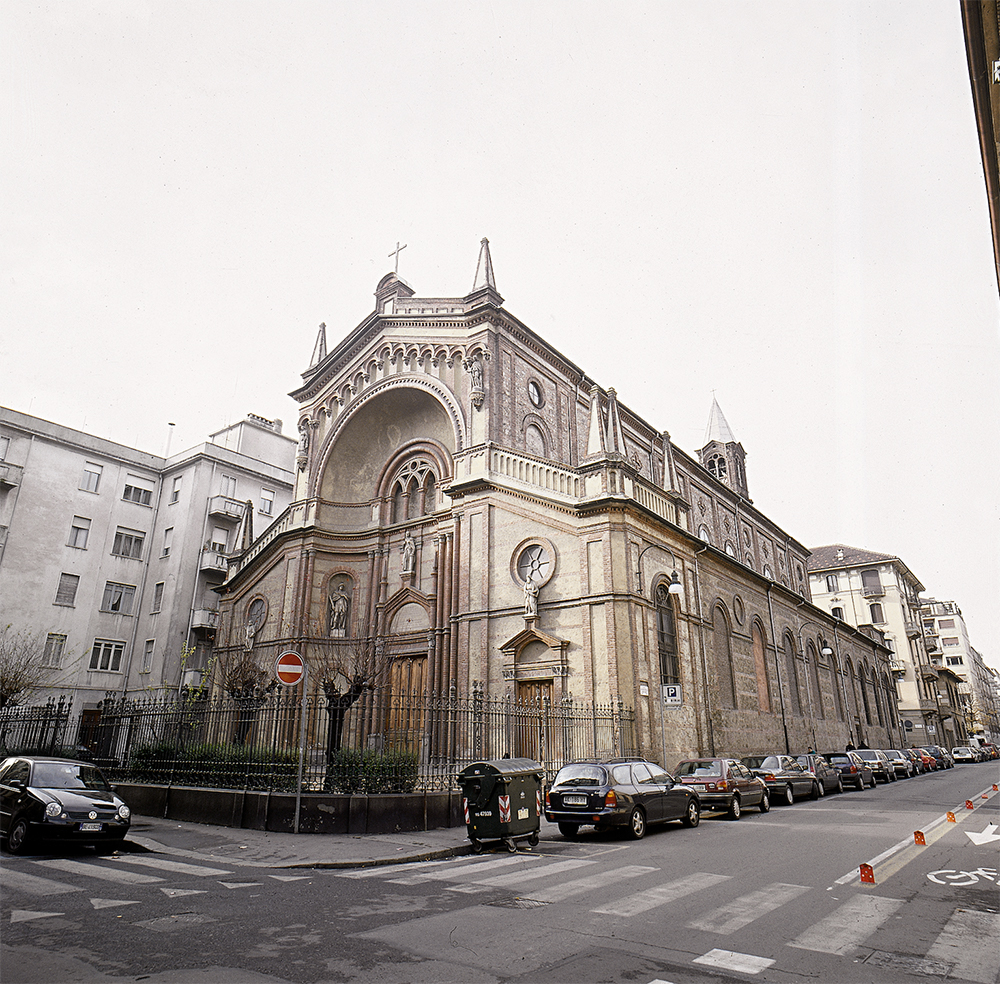
"The church of Santa Barbara, as well as the Collegio Artigianelli, is located within that area of the city previously occupied by the Citadel, a very impressive military fortress, built in the 16th century and definitively demolished (except for the Keep) in 1856-1857 to make way for urban southwestern growth.
Inside the Citadel there was a church dedicated to Santa Barbara, patron saint of bomb squads and gunners. The current church, built between 1867 and 1869, replaces the one that was demolished together with the military citadel to which it was part. It is the Byzantine work of the architect Pietro Carrera.
It is the parish in whose territory the Collegio Artigianelli is located. Murialdo's funeral was celebrated here on April 1, 1900. A huge crowd paraded in procession and then poured into the church, filling it up to the point of unbelievable. Many accompanied the body to the General (or Monumental) Cemetery of Turin, witnessing its burial in the family tomb.
Murialdo often celebrated mass in this church. The sacristan stated that he had never seen a priest "who prayed so long before and after the celebration of the mass".
To the right of those who enter is the altar of the Madonna of Pompeii. The painting of the Madonna del Rosario (1894) is by Enrico Reffo. The altar was designed and sculpted by the Josephite lay brother Giovanni Massoglia.
The following altar preserves a relic of St. Leonard, the left humerus, which the congregation wished to donate to the church as a sign of gratitude for having kept the remains of the founder from 1917 to 1971.
After the door of the side entrance you can see the upper part of Murialdo's sepulchral monument, erected in 1926. The design is by Anacleto Barbieri (Reffo School), the execution of prof. Bosco. The aedicule supported by columns and shelves had already been placed on Murialdo's tomb in the Monumental Cemetery of Turin, together with the bust of Murialdo which now stands in the center of the portico of the Artigianelli College. This one found here in Santa Barbara is a copy made by our confrere Massoglia.
The two side bas-reliefs recall the saint's activity among poor and abandoned children. At the foot of the monument there was the sarcophagus, which is now preserved empty in the Collegio Artigianelli.
On 6 June 1971 the remains of Murialdo were transferred to the sanctuary of Our Lady of Health.
At the end of the right aisle, closed by a door, is the chapel of the Madonna della Misericordia. It recalls the apparition of the Madonna to the peasant Antonio Botta, which took place a few kilometers from Savona, on March 18, 1536, in the place where today the sanctuary dear to Murialdo stands for having prayed there several times during his stay in the college of the School Fathers. Pie. Murialdo often stayed for the preparation and thanksgiving of the mass in this chapel which reminded him of the sanctuary of Savona and which bore a Marian title dear to his heart and close to his spiritual experience.
Moving now to the left aisle, in front of the entrance to the sacristy you will find the place of Murialdo's first burial in this church (1917). A niche was prepared under the floor, closed by a plaque, still visible today, with the inscription “Hic ossi sacerdotis Leonardi Murialdo”. Later the tomb was adorned with a wooden gate and with the aedicule and bust that were already at the family burial in the General Cemetery and which still embellish the funeral monument of 1926 today.
Going towards the exit (main door) you pass in front of the altar of the Sacred Heart, the first in the left aisle for those entering the church. The altarpiece (1888) is the work of Enrico Reffo. Marble, altar and balustrades are by Giovanni Massoglia."
The Birth house of Murialdo
- Via Garibaldi, 31 – Torino
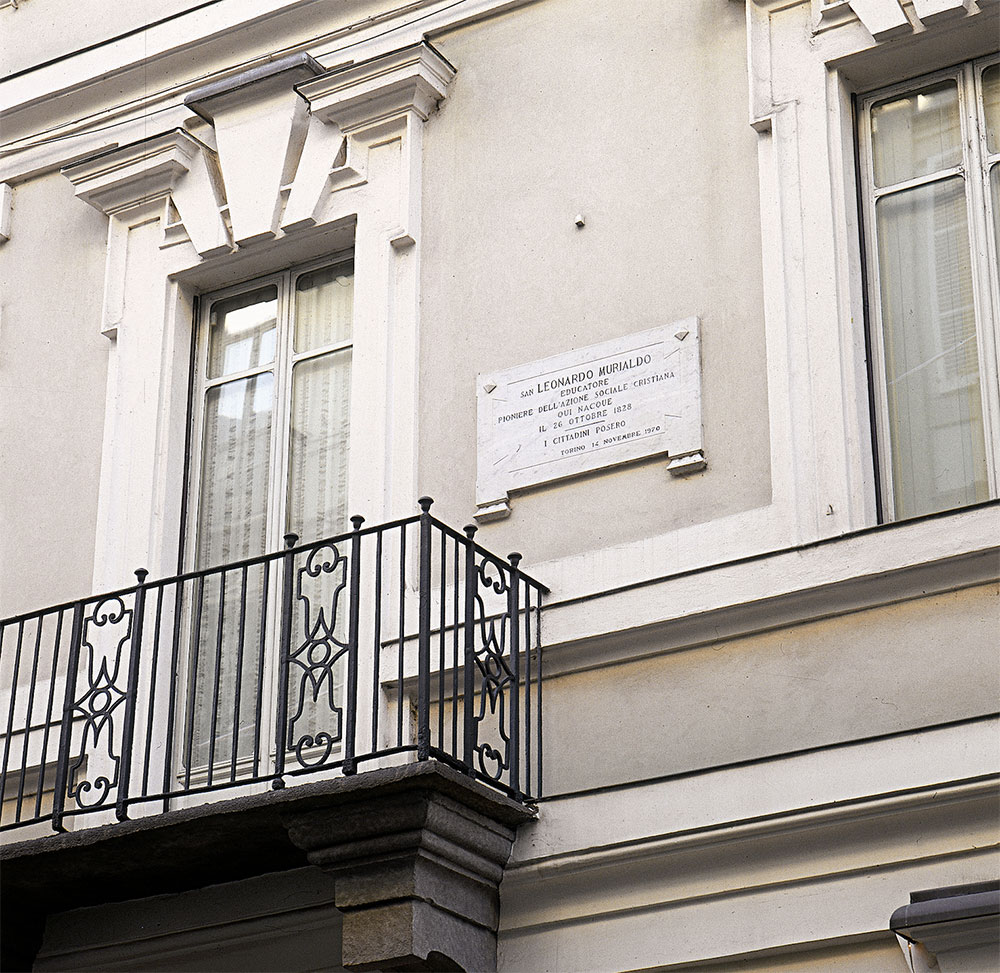
The house where Murialdo was born on 26 October 1828 was located in the building at the corner between Via Garibaldi and Via Stampatori. The name of Garibaldi was given to the street only in 1882, after the death of the head of the Thousand. called Dora Grossa.
The Murialdo family apartment was on the third floor. Some windows overlooked Via Stampatori, others onto Via Dora Grossa. For obvious reasons of legibility, the plaque commemorating the birth of Murialdo was placed at the height of the first floor.
The eighteenth-century Palazzo San Martino della Motta (later Balbo Bertone di Sambuy), in which Murialdo's house was located, overlooks Via Garibaldi with numbers 31 and 33. The apartment could be accessed from no. 31 of what was once Via Dora Grossa, but more commonly the Murialdo family used the entrance on Via Stampatori, n. 10, now no longer numbered, because it is closed and occupied by a shop.
The Murialdo apartment was large and elegant. In the will left by Nadino's father, it is described and at least 12 different environments are named: entrance, reception room, two living rooms, dining room, kitchen, study, corridor and four bedrooms. In addition, there were two attics and a well-stocked cellar. It must be remembered that the Murialdo family was numerous: father, mother, six daughters (one had died as a child) and two sons.
Murialdo's childhood was saddened by the death of his father, which took place on June 15, 1833, at the age of 56, when Leonardo was not yet five years old and his younger sister, the last of the family, had not yet reached the third.
Leonardo and Ernesto left from this house to go to the boarding school in Savona on the evening of October 26, 1836. They would never return to Turin until the summer of 1843.
His sisters also left from here, for the wedding, until Ernesto and Leonardo, left alone at home, in 1858 moved to other apartments, depending on the years, in piazza Maria Teresa, via Cavour, via Po.
Meanwhile, Mother Teresa had died in this house on July 9, 1849, without seeing the priestly ordination of Nadino, who at that time had just finished the fourth of five years of the theological course.
The Church of st. Dalmazzo
- Via Garibaldi, angolo Via delle Orfane – Torino
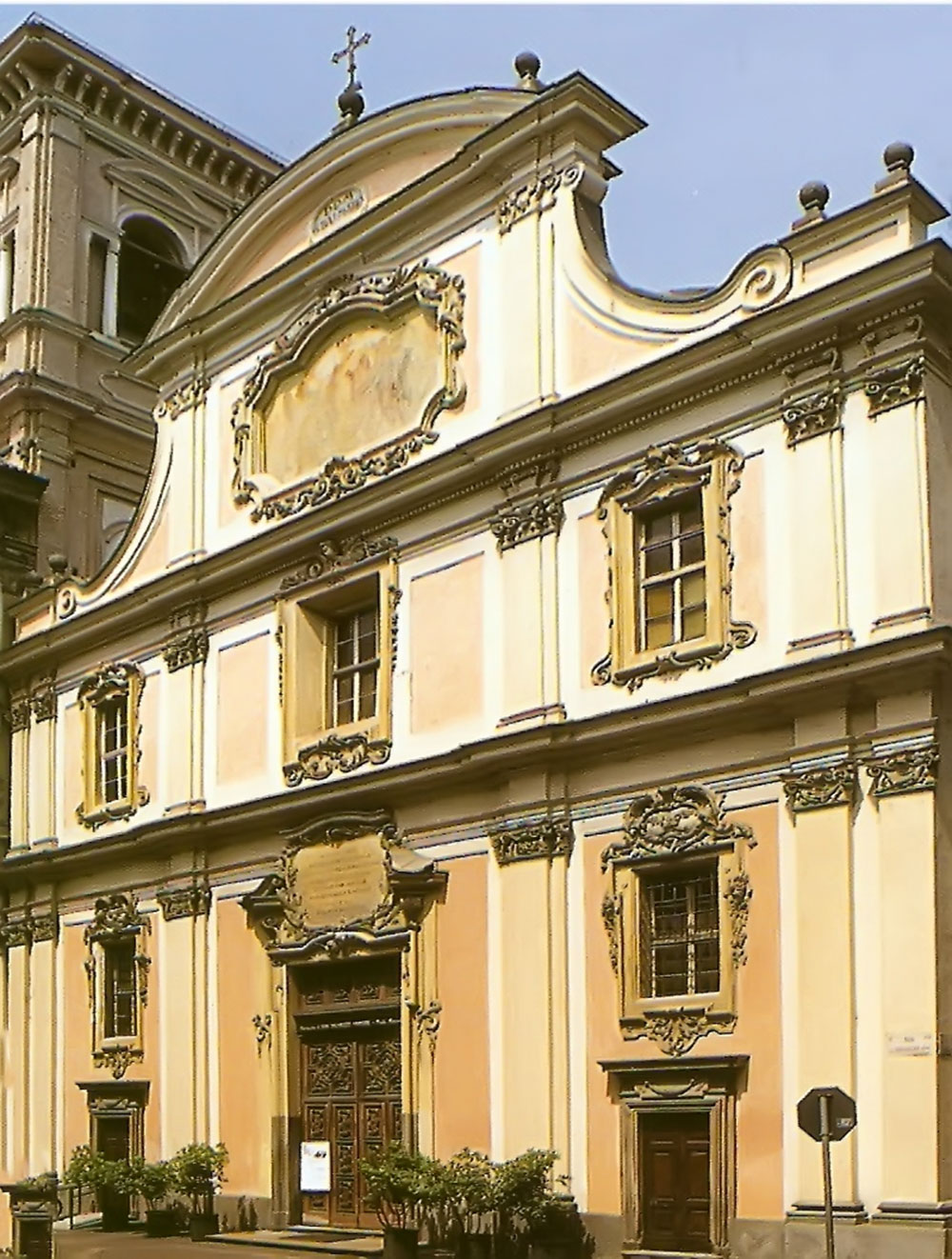
It was built in 1530 on the site of a previous medieval church and then restored and embellished several times during the eighteenth and nineteenth centuries.
The interior of the church, as we see it today, does not entirely correspond to that of Murialdo's time, due to the transformations that the building underwent between the nineteenth and twentieth centuries. San Leonardo describes this church in his spiritual Testament referring to the time of his youth and recalling the events of his baptism (1827), his first confession, his confession after his return from Savona (1843), the sermon that guided him towards a vocation priestly (at the end of 1843), of his first mass (1851).
Here is how Murialdo remembers his parish church, almost in the form of a prayer.
«I enter your temple, oh my God. What an impression of peace and love! In fact, here everything speaks to me of love: of that love you had and still have for me, and of that love that I owe you».
As soon as you enter, on the right, there is the baptismal font, where Leonardo was baptized on the evening of 27 October 1828. A plaque commemorates the event.
«Here is the sacred source where your love gave me innocence and adopted me as your son by means of holy baptism».
Continuing in the right aisle, Murialdo recalls the confessional where his first confession took place and above all the confession of his return to God (September 1843), after the crisis he had gone through in the last year he spent in Savona.
«I take a few steps forward and see the sacred tribunal where, through your minister, Abbot Pullini, you gave me back for the first time purity and peace of heart in my childhood, but above all when, in 1843, on my return from the college of Savona, a true prodigal son, laden with a thousand sins, I came to confess to you: "Father, I have sinned against heaven and against you”. Then you opened your paternal heart to my prayer, you listened to this prayer and returned to possession of a soul destined to be your temple, but which for so long had only been the abode of demons. Oh, how your infinite mercy became me sensitive then!».
«Further ahead is the sacred pulpit. It is down there that, for the first time, you made me hear your call to religious life. The fear of hell and the human respect, which in college had dragged me along the paths of eternal damnation, were the chains with which you attracted me to you. I thought that if I had been away from the world, I would no longer have difficulties because of human respect. My first thought was to ask to become a Capuchin friar, but I was dissuaded by canon Renaldi who advised me to embrace the priestly life where I would have no more to fear human respect than among the Capuchins». The "human respect" Murialdo talks about is the fear he felt in front of his schoolmates in Savona, who mocked him for his kindness and commitment. He was so conditioned that he went into crisis and changed many of his behaviors for the worse.
Following the chronology indicated by Murialdo himself, one can advance the hypothesis that the sermon heard under the "sacred pulpit", the one in which he "for the first time", moved by the "fear of hell", felt the "call to religious life ”, took place towards the end of 1843.
For Saint Leonard it was the beginning of his vocation, first priestly and later religious. The pulpit, in its present form and location, dates back to the great works that radically transformed the church of San Dalmazzo from 1885 to the early twentieth century.
At the time of Murialdo, however, the pulpit was further ahead, resting on the pillar of the cross.
In the church of San Dalmazzo there is yet another "Murialdine" place: it is the chapel of the Madonna of Loreto, to the left of the main altar. It is a place that reminded Murialdo of a dramatic period from a psychological point of view, following the decision to become a priest. Precisely in order to be faithful to the path he had just taken, Leonardo had intensified his spiritual and ascetic commitment, while perhaps the sense of guilt for the sins he had committed was growing in him and even more for having "abandoned" God during the Savona crisis. The spiritual readings of the time, all centered on death, eternity and the fear of hell, were added to probably cause him a state of anxiety and anguish that made him fear a serious and irreversible nervous breakdown. Recourse to Mary in this chapel brought him liberation.
But the church of San Dalmazzo is linked to perhaps the most beautiful memory of the life of San Leonardo: his first mass. «On 21 September 1851, the feast of San Matteo, I had the glory and the joy of celebrating the first mass in the church of San Dalmazzo. How happy I was! But my mother was not among the relatives who crowned me. She had gone to heaven on July 9, 1849 "«On that happy day, my God, you gave me the grace of absolute abandonment to you. I was detached from the pleasures of the world, I was all yours! ».
Returning to the center of the church, you can admire the walls of the transept and the central nave, decorated with encaustic on a gold background by Enrico Reffo who wanted to depict a long line of saints, men and women, which converge towards the presbytery. In the transept, the right altar, dedicated to St. Paul, is embellished with paintings, also by Reffo, depicting the Apostle, St. Charles Borromeo, St. Francis de Sales and other saints. Saint Anthony Maria Zaccaria, founder of the Barnabites, once custodians of the church, is portrayed in surplice and stole, kneeling and in the act of pointing to the Eucharist. On the right, also kneeling, wearing episcopal robes, is the Barnabite Saint Alexander Sauli. Di Reffo and his school are also the four evangelists of the glass lunette that dominates the altar and in general all the decoration of the church.Reffo left his self-portrait in the left transept, among the “Sancti discipuli Domini”: he is the third from the right; his figure appears above the head of a bent over and shirtless man.
Near the exit, note, in the left aisle (right for those who exit), the last chapel, with three paintings by Reffo, including the central one of the Sacred Heart, from 1881, and the gate made by the blacksmiths of the Collegio Artigianelli, who signed it: “Collegio Artigianelli, Turin 1882”.
Immediately afterwards, leaning against the wall, is the bust of the painter Reffo.
The Church of St. Clare
- Via delle Orfane, angolo Via Santa Chiara – Torino
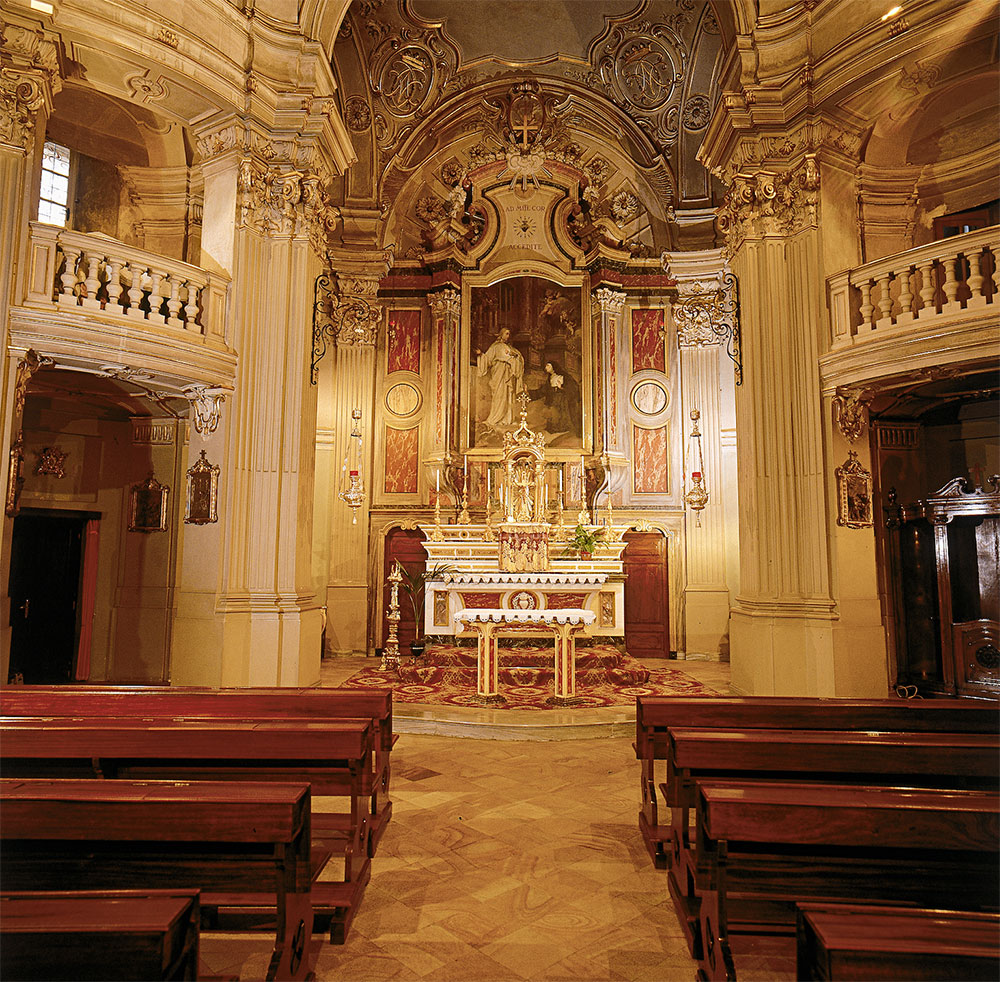
The small church of St. Clare, annexed to the monastery of the Poor Clares, was built in 1745 by Bernardo Vittone. The Sisters of the Visitation took over the Poor Clares in 1824. Now the monastery and church no longer host any religious congregation.
Murialdo speaks of this church in his spiritual Testament. He calls it "church of Santa Chiara", but also "church of the Visitation", since it belonged to the Sisters of the Visitation in his time, even if more properly this was the name of another sacred building, the one in which he was ordained a priest.
«How I love the little church of the Visitation! On November 6, 1845, the feast of St. Leonard, I had the joy and honor of wearing the clerical habit blessed by Abbot Pullini in the church of Santa Chiara, annexed to the convent of the religious of the Visitation, of which the abbot was the father spiritual. The whole family, my mother first, was present. Nobody, except my confessor, Abbot Pullini, knew anything about my sad past ".
But the Savona crisis was now over and Leonardo had already had the experience of "God infinitely good, infinitely merciful" who had forgiven his previous abandonment and indeed had chosen him "for the most sublime, the most divine vocation, for the priestly life ".
However, it seems that Murialdo is wrong in placing the dressing on November 6. In fact, the official documents, preserved both in the Archdiocese of Turin and in that of the Generalate of Rome, indicate that the function took place the following day, Friday 7 November.
In any case, Murialdo was wearing the priestly habit and was ready to begin his Theology courses at the University.
The sanctury of Consolata
- Piazza della Consolata – Torino
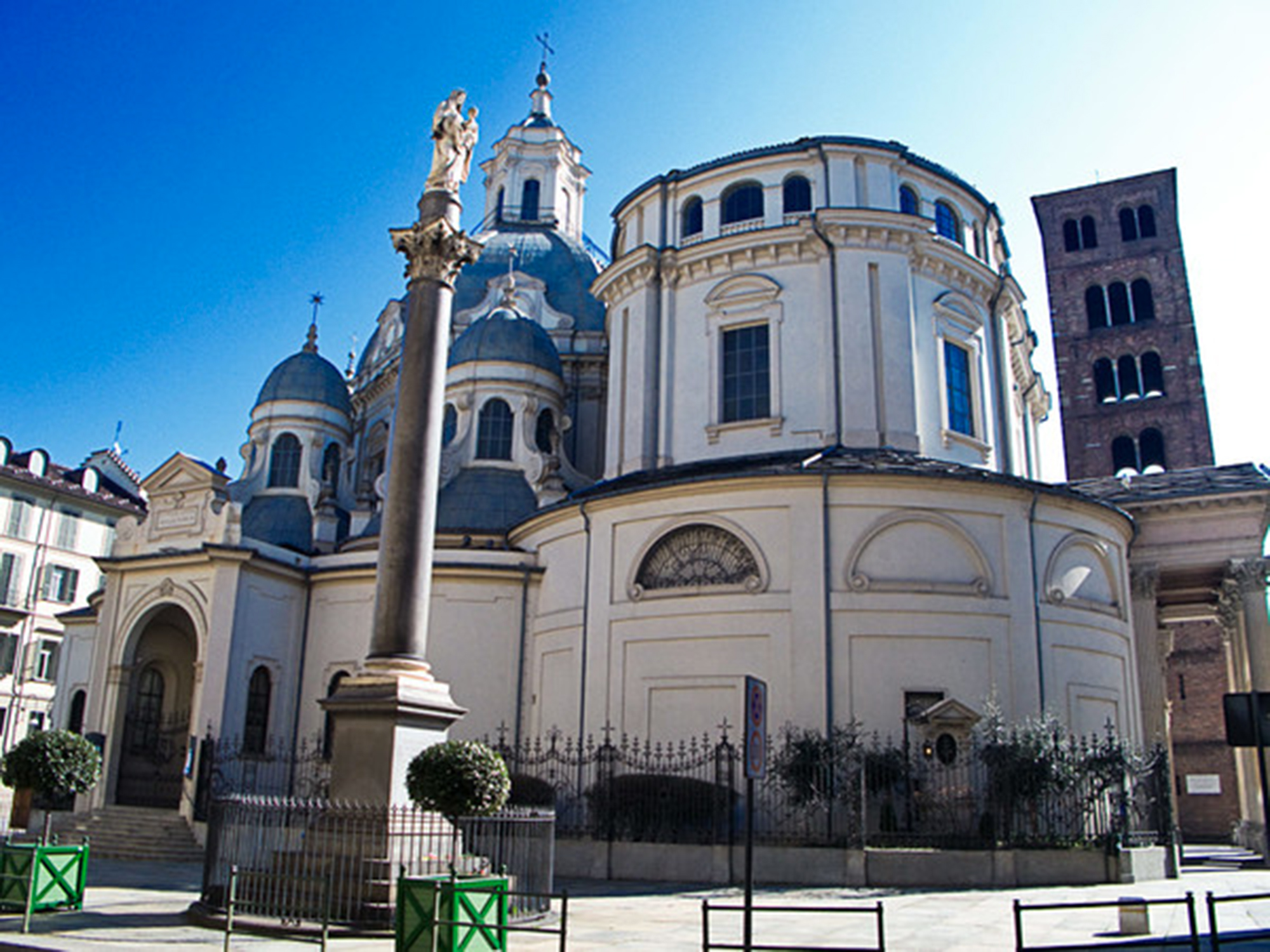
It is the most famous and dearest church to the Turinese. The facade, neoclassical, dates back to 1860, but the church has a much older history.
According to tradition, the painting of the Madonna that is venerated there (main altar) belonged to the old church of Sant’Andrea, now in ruins. Lost under the ruins of the building, it was found by a blind man from Briançon (Jean Ravache) on June 20, 1104. The "rediscovery" started the construction, on the same site, of a new church, in Romanesque style ( the bell tower remains), then replaced by the current Baroque sanctuary, begun by Guarino Guarini in 1678 and completed in essential lines twenty years after his death, in 1703. The dome was finished in 1717. The main altar is by Filippo Juvarra (1729). The interior underwent further important changes between the end of the nineteenth century and the beginning of the twentieth century.
L’interno è al tempo stesso complesso ed armonico, essendo in pratica costituito da tre diverse chiese attigue e comunicanti. Appena entrati, ci si trova nella chiesa di Sant’Andrea. Conserva la configurazione ellittica progettata da Guarino Guarini. L’altare principale è sulla sinistra: vi si può ammirare il dipinto che raffigura il martirio di Sant’Andrea, del Reffo (1904).
L’altare di San Giuseppe Cafasso è ornato da un quadro di Luigi Guglielmino, mentre l’urna in bronzo che contiene le reliquie del santo è stata eseguita da Anacleto Barbieri (entrambi gli autori appartenevano alla Scuola Reffo).
Ben a ragione Cafasso è sepolto in questa chiesa, cuore religioso di Torino, egli che ebbe una parte così notevole nella formazione spirituale e pastorale di tante generazioni di sacerdoti, suoi allievi al Convitto Ecclesiastico di San Francesco di cui fu rettore dal 1848 al 1860, anno della morte. Quel Convitto continuò poi qui alla Consolata, sotto la guida del beato Giuseppe Allamano, fondatore dei Missionari e delle Missionarie della Consolata.
Alcuni scalini ed una cancellata immettono nel vero e proprio santuario della Consolata, di forma esagonale, progettato da Guarini nel sec. XVII e ingrandito nel 1899 con le quattro cappelle ovali che lo circondano.
Il grandioso altare di Filippo Juvarra incornicia e sorregge il quadro della Madonna Consolata (Consolatrice degli afflitti), olio su lino, risalente alla fine del XV secolo, imitazione dell’icona di S. Maria del Popolo a Roma (Piazza del Popolo).
Mentre ci si avvia verso l’uscita, si nota a sinistra la cappella della Madonna delle Grazie, alquanto al di sotto del livello della chiesa di Sant’Andrea. Qui, tra le rovine dell’antico edificio sacro, secondo la tradizione, sarebbe stata ritrovata l’effigie della Madonna da parte del cieco di Briançon il 20 giugno 1104.
Don Reffo racconta che la madre di Leonardo era molto devota della Consolata e aveva fatto dono dei suoi diamanti al santuario. Alla Consolata poi essa affidò i suoi due figli, Ernesto e Nadino, prima della loro partenza (1836) per il collegio di Savona.
Il ricordo di questo “affidamento” è presente anche nel Testamento spirituale del Murialdo ed è accompagnato dal ringraziamento alla Madonna, la cui protezione si fece sentire durante la crisi giovanile a Savona.
Diventato sacerdote e poi Rettore del Collegio Artigianelli, il Murialdo partecipò, qui alla Consolata, a molte delle manifestazioni religiose che avevano nel santuario il loro centro, prima fra tutte la festa liturgica, con la solenne processione, il 20 giugno.
Alle porte di questa chiesa egli venne parecchie volte a chiedere l’elemosina, per i suoi ragazzi del Collegio Artigianelli. Andò anche alle porte di altre chiese, specialmente in quaresima, ed era un gesto che costava tantissimo a uno come lui, proveniente da una famiglia agiata e ben conosciuta in città.
La devozione del Murialdo alla Consolata si manifestò particolarmente in occasione della fondazione della Congregazione. Egli volle che si celebrassero parecchie messe nel santuario per ottenere la protezione di Maria sul gruppo di religiosi che stava per nascere. Il 19 marzo 1873, al mattino, avvenne la fondazione. Nel pomeriggio, i primi sei giuseppini e i primi due novizi si recarono alla Consolata per ringraziare la Madonna.
Del resto la stessa idea centrale del Murialdo sulla devozione alla Madonna, quella di Maria mediatrice di ogni dono e di ogni grazia che ci viene da Dio, trovava uno dei suoi fondamenti proprio nell’orazione liturgica della festa della Consolata, approvata da Leone XIII nel 1885: «O Signore nostro Gesù Cristo, che con ineffabile provvidenza hai disposto che noi otteniamo tutte le grazie per mezzo della Madre tua Maria, concedici propizio che sempre siamo assistiti dall’aiuto e dalla protezione di colei che solennemente onoriamo sotto il titolo soavissimo della Consolazione».
Ogni sabato egli si recava a pregare in questo santuario e desiderava che i confratelli di Torino, potendolo, facessero altrettanto; quelli delle altre case poi li esortava a visitare «la cara Madre di tutte le consolazioni» in occasione dei loro viaggi a Torino.
Tornati all’esterno, si osservi, a sinistra dell’ingresso del santuario (e a destra per chi esce), la colonna in granito sorreggente una statua della Vergine. Si tratta dell’adempimento di un voto fatto dai Torinesi alla Madonna, quando la città di Torino fu risparmiata dal colera del 1835 che si era invece diffuso in molte altre parti del regno di Sardegna.
Nel giardinetto adiacente alla parete sinistra del santuario si conserva un pilastrino con l’immagine della Consolata. Era uno dei tanti collocati in segno di ringraziamento lungo quella che era stata la linea di combattimento durante il minaccioso e per fortuna vano assedio francese del 1706. Altri pilastrini di questo tipo sono custoditi nella chiesa di Nostra Signora della Salute.
In prossimità dell’incrocio tra Via della Consolata e Via Giulio, è visibile l’angolo nord-occidentale della cinta muraria romana, riportato alla luce nel 1884.
The Church of visitation
- Via XX Settembre, angolo Via Arcivescovado – Torino
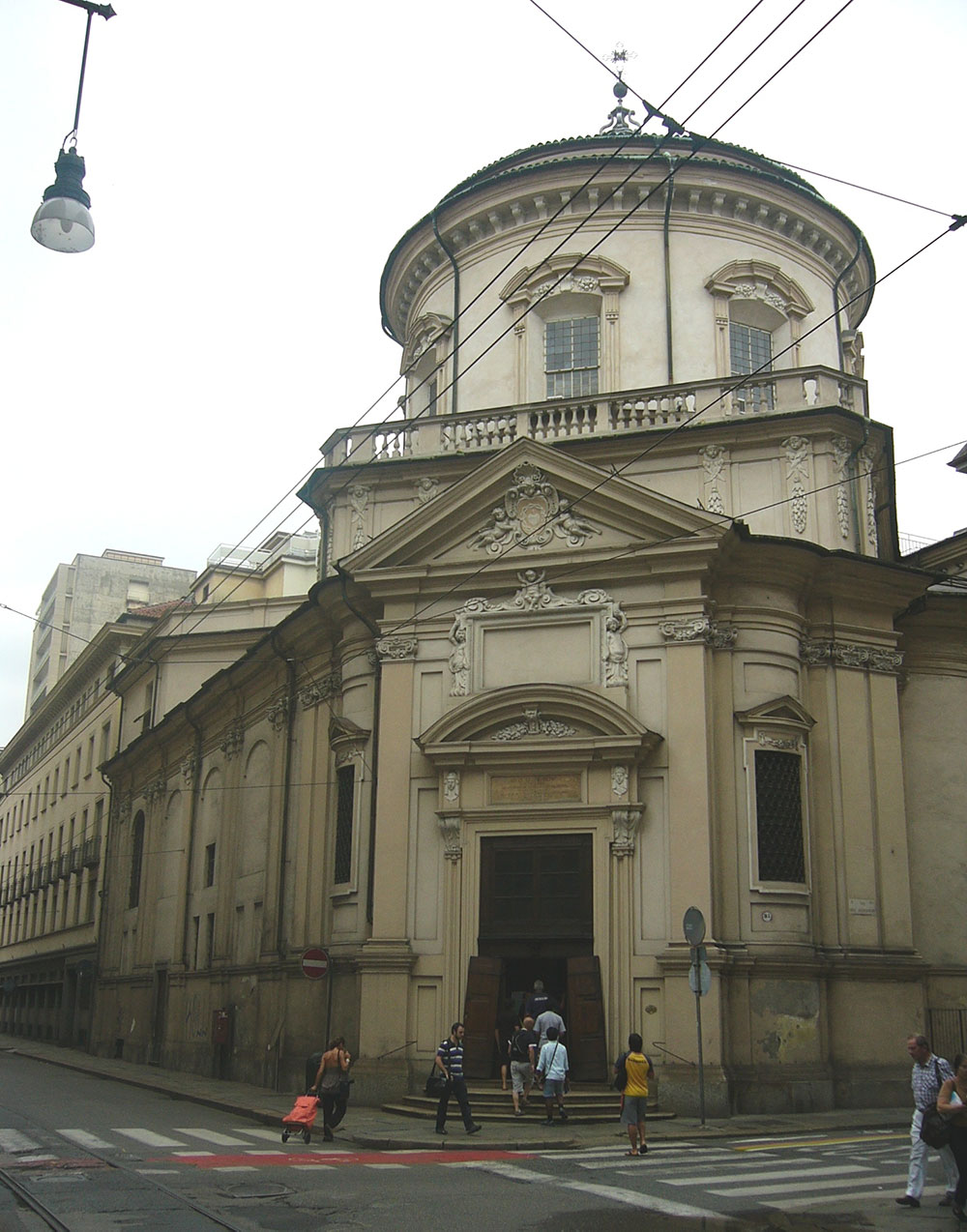
It is the masterpiece of Francesco Lanfranchi, who built it in the second half of the 1600s for the Visitation nuns to whose convent it was annexed. The nuns were then expelled by the French in 1802, following the suppression of religious orders. convent passed to the Mission Fathers, founded by San Vincenzo de Paoli, who still officiate the church.
In the chapel on the right, a plaque remembers that this church is linked to the memory of Murialdo's priestly ordination. The icon (the Sacred Heart invoked by St. Vincent de Paul, 1898) is by Luigi Guglielmino, a pupil of Reffo.
During his theology Murialdo frequented this church because the Company of San Tommaso d’Aquino to which he had enrolled was located here. It gathered many clerics and priests (a hundred or more), with educational and religious intentions. The participants gathered every Sunday, from 7.30 to 8.30, for prayer, spiritual reading and a lecture given by the director.The Biblical-Oratory Academy was established in 1852 at the Mission House and at the Church of the Visitation. Murialdo, formerly a priest, occasionally took part in his weekly meetings (on Thursdays) under the guidance of a well-known Lazarist father, Giuseppe Buroni. They studied the Bible and practiced preaching nourished by Holy Scripture and accessible to the people. Some years later, Don Eugenio Reffo and Don Giulio Costantino were also part of this new center of formation and priestly commitment.Every year the "external" clerics, that is, who did not reside in the seminary, made spiritual exercises in the Mission House in preparation for ordinations to the sub-diaconate, the diaconate and the presbyterate. The two internal chapels of the house served this purpose.
Here, therefore, in the house of the Mission, Murialdo prepared himself with spiritual exercises for his ordinations which he received not in this church, but in an internal chapel of the house. He was ordained a sub-deacon on 21 September 1850, then a deacon on 5 April 1851 and finally a priest on 20 September 1851.
In the spiritual Testament Murialdo reads the story of his vocation as a great and unexpected gift from God.“The good Lord, really good to me, almost forced me to follow the two most sublime vocations in the world: the priestly and the religious, not to mention the more necessary one, the Christian vocation.As for the priestly vocation, I had never thought about it.Child, I dreamed of becoming an official one day. In college I planned to study law, because some Fathers, not very cautious, flattered me by telling me that I would become a minister of state.During the philosophy course I thought of studying the mathematical sciences, because I saw that the era of the luck of engineers was approaching.Yet God chose me! He called me, he even forced me to honor, glory, the ineffable happiness of being his minister, of being "another Christ", of being "after God, an earthly God".
Oratory of St. Luigi
- Corso Vittorio Emanuele II, 13 – Torino
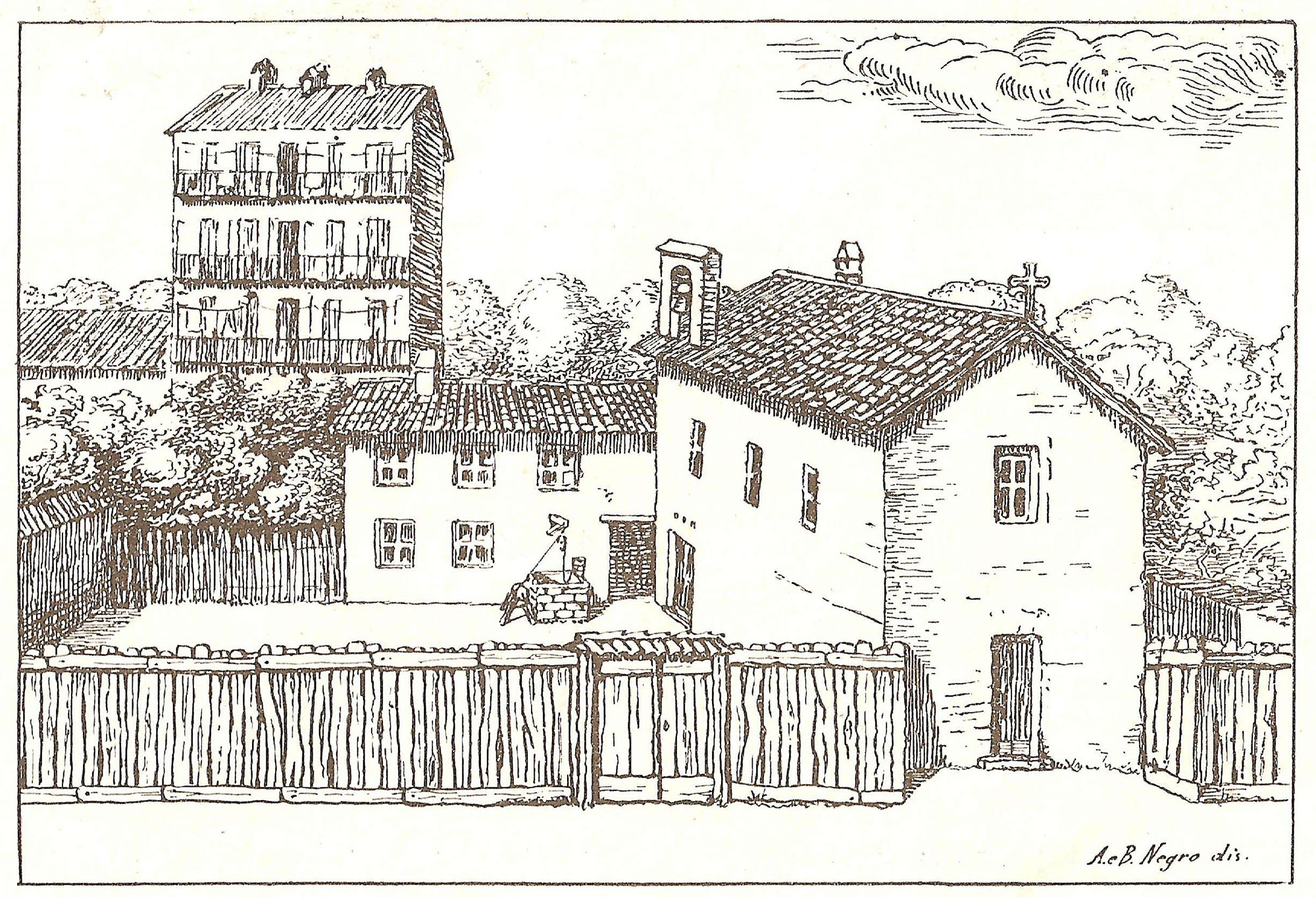
In Corso Vittorio Emanuele II, between Via Madama Cristina and Via Ormea, is the church of San Giovanni Evangelista (San Giovannino). The church was built between 1877 and 1882 in the Lombard-Romanesque style by Edoardo Arborio Mella on the initiative of Don Bosco. The painting of the apse (imitating a Byzantine mosaic), by Enrico Reffo, represents Jesus on the cross pointing to the Madonna the disciple John entrusting him to him as his son. The frescoes in the presbytery concerning the evangelist John are also due to the brush of Reffo , the medallions depicting the bishops of Asia Minor mentioned in the Apocalypse (six in the central nave and one on the internal facade, above the organ) and the painting of St. Joseph (1882), which is located on the second altar in the right aisle.
Here, in the place now occupied by the altar and the apse of the church, there was the Oratory of San Luigi, founded by Don Bosco in 1847. It was the third in the city, after that of the Guardian Angel opened by Don Cocchi in 1840 and that of St. Francis de Sales, begun by Don Bosco himself in 1844.
Fr Giacinto Càrpano, Don Pietro Ponte and then Paolo Francesco Rossi, a young priest, the same age and friend of Leonardo Murialdo, who went to help him in the catechism of children, followed one another. Rossi, however, died prematurely on November 5, 1856 and for several months the oratory did not have a priest who would take responsibility for it. It was brought forward by the lawyer Gaetano Bellingeri, "a layman who had the heart of an apostle", also the same age as Murialdo and his companion in the philosophy course (high school).The oratory opened on Sundays and offered the children of the southern suburbs of Turin the opportunity to attend mass, to confess, to play, to receive catechetical instruction that they could not find in their parishes, often far away, and not only geographically. their interests and their problems.
From the earliest times, the crowding was really great: 450-500 boys, the sources say, and it's hard to believe, given the paucity of the facilities.
Murialdo entered the oratory as director on Sunday 26 July 1857. In Lent the oratory opened its doors every day and not only on Sundays.
For many of those children, who did not attend the few existing municipal schools, an elementary school was opened, which gathered from 70 to 90 children, depending on the time of the year.Murialdo and the laity of the Conferences of San Vincenzo supported the expenses for the construction works, for the functioning of the school, for the salary of the teachers, for the prizes to the children, many of whom were also helped financially with some subsidies to the families, in the style of San Vincenzo.
Then, every Sunday, the Salesian clerics came from Valdocco, who placed themselves under Murialdo's service for catechism and games.
For Murialdo, the beautiful and intense period of St. Louis ended in September 1865 when he left to spend a year of study in the Parisian seminary of San Sulpizio, thus enriching his apostolic baggage with a new experience, in view of future commitments in favor of young people.
Villa Murialdo
- Strada Sant’Anna, 79 – Torino
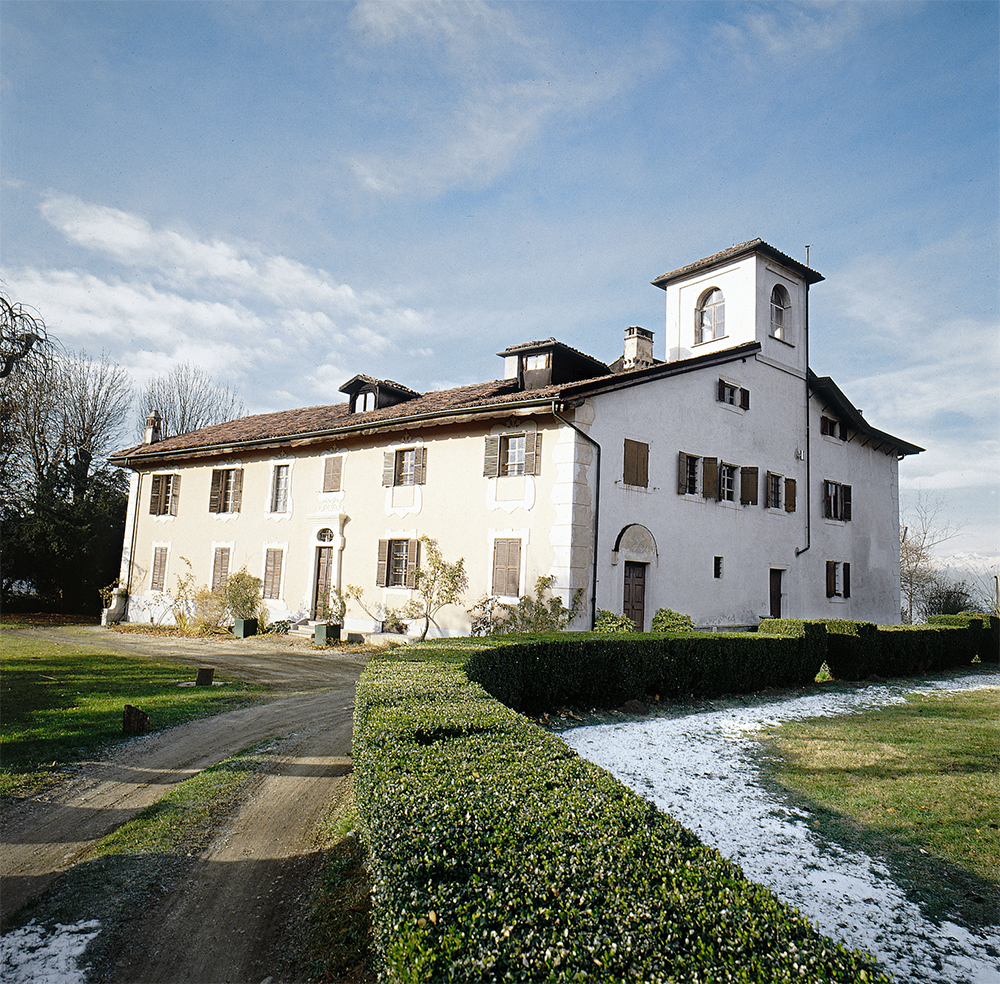
The inscription" Villa Murialdo "appeared on the pillars of the gate at the time it belonged to the descendants of the Murialdo family, that is, until 2000. It was previously called" il Rubino ", from the name of the ancient owners. It was bought by Franchino Murialdo, father of Leonardo, in 1824. It included a fairly large piece of land with a civil and rustic house, vineyard, field, lawn, garden and wood.
On the death of Franchino Murialdo, the villa was inherited by the two sons, Ernesto and Leonardo, who, together with their mother, while they lived, and their sisters, spent their summer holidays there, or periods of convalescence during some illness.
The elevated turret on the north side is from the nineteenth century. The façade (east side) is decorated with liberty-style friezes that are subsequent to the time of San Leonardo. On the first floor, the second window from the left is that of the saint's room.
On the ground floor there was the dining room, with a beautiful billiard table, the kitchen, another room with a piano (harpsichord) and the chapel in which Murialdo celebrated mass.The villa was the destination of various walks for the boys of the San Luigi Oratory, of the San Martino and of the Collegio Artigianelli. Sometimes Don Bosco also took his young people there.A regular appointment at the villa, for Murialdo, was that of the evening of the Saints, with all his family, for the recitation of the rosary in suffrage for his dead: it was a custom to which he tried to remain faithful, as long as his health he allowed, that is until almost the end of his life.
The welcome to the villa had to be exquisite and cordial, if Murialdo took the cue to talk to his Giuseppini about the affability and family spirit. He wanted an atmosphere of joy and festive welcome to be created in the community, so that there would not be an extra dish at the table, but, as they used to say, above all a plate of good wax: "at the villa, at my mother, there were no big lunches, but there was always a plate of good wax ».
The University
- Via Verdi, 8 – Torino
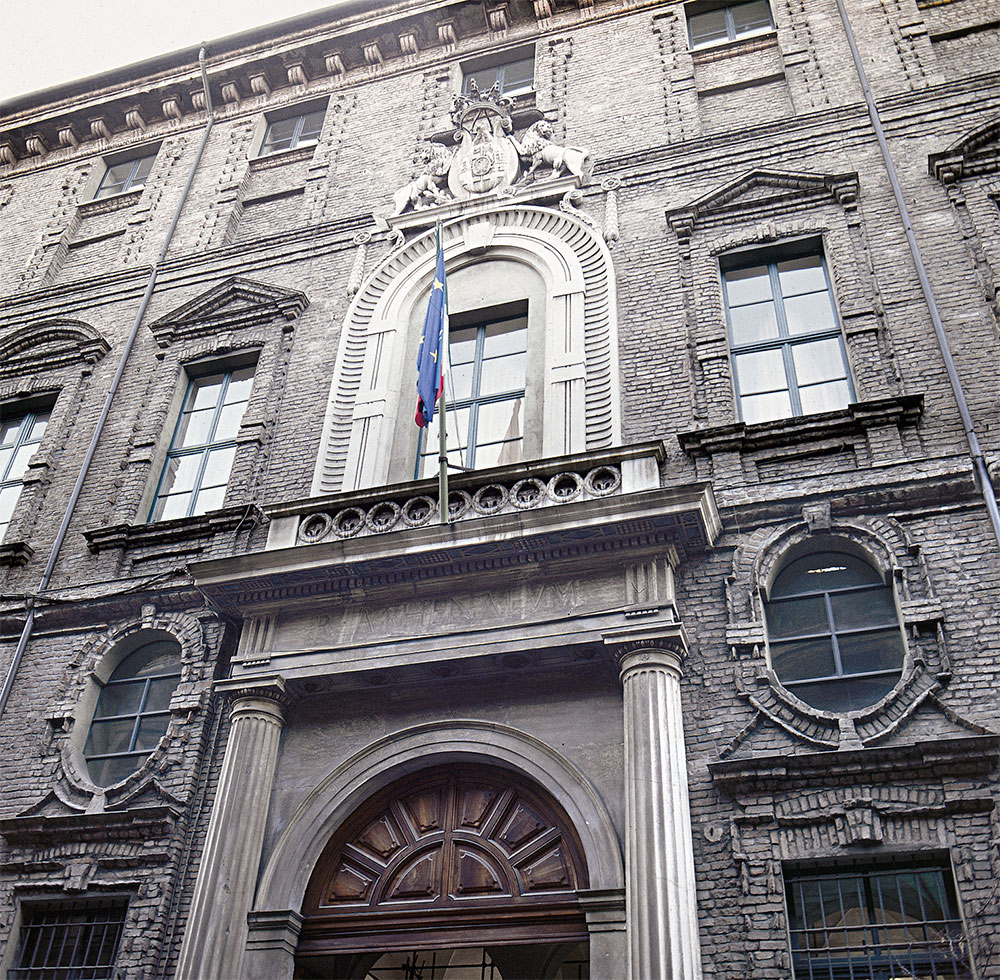
The University Palace, commissioned by Vittorio Amedeo II, was inaugurated in 1720. The main facade, in terracotta, is the one on Via Verdi, by Filippo Juvarra. The porticoed courtyard and loggia are very spectacular.
Murialdo began his university theological five-year period in the autumn of 1845. The subjects of the first year were: Theological institutions (= fundamental theology), Biblical institutions (= Introduction to Sacred Scripture), Moral Theology, Scholastic-Dogmatic Theology, Sacred Scripture. Special moral lessons were then activated, called “moral conferences”. Other subjects, although important, were not studied at the time (Church History, Patrology, Pastoral Theology, Liturgy). The latter was only partially replaced by the Thursday meetings in which students had to participate in the so-called "school of ceremonies", which Leonardo followed in Santa Maria di Piazza.
Precisely in that year 1845-46 the traditional method of teaching by dictation by professors began to disappear, gradually replaced by the use of printed treatises, of which the teachers themselves were authors. This was required by a provision of the Reform Magistrate, the equivalent of the current Minister of Education.
Here too, as in the philosophy course, the system of "repeaters" worked. During school the students took notes and then, during the "repetition", the repeater questioned the students about the lesson of the day before and then summarized and re-explained the last lesson, then assigning it to be studied by heart.
At the end of the fifth year, on May 8, 1850, Murialdo graduated in theology. The degree did not consist in the defense of a previously written thesis, but in a real examination on various parts of the whole theological curriculum. The Minister of Education, who was then Cristoforo Mameli, also attended Murialdo's examination. That was a sign of distinction, reserved for the two best students of each Faculty.
From that moment he was a "theologian": that title distinguished him from those who finished their studies without academic degrees and was simply called "don".
Family Home for young workers and students
- Piazza Santa Giulia, 4-8 – Torino
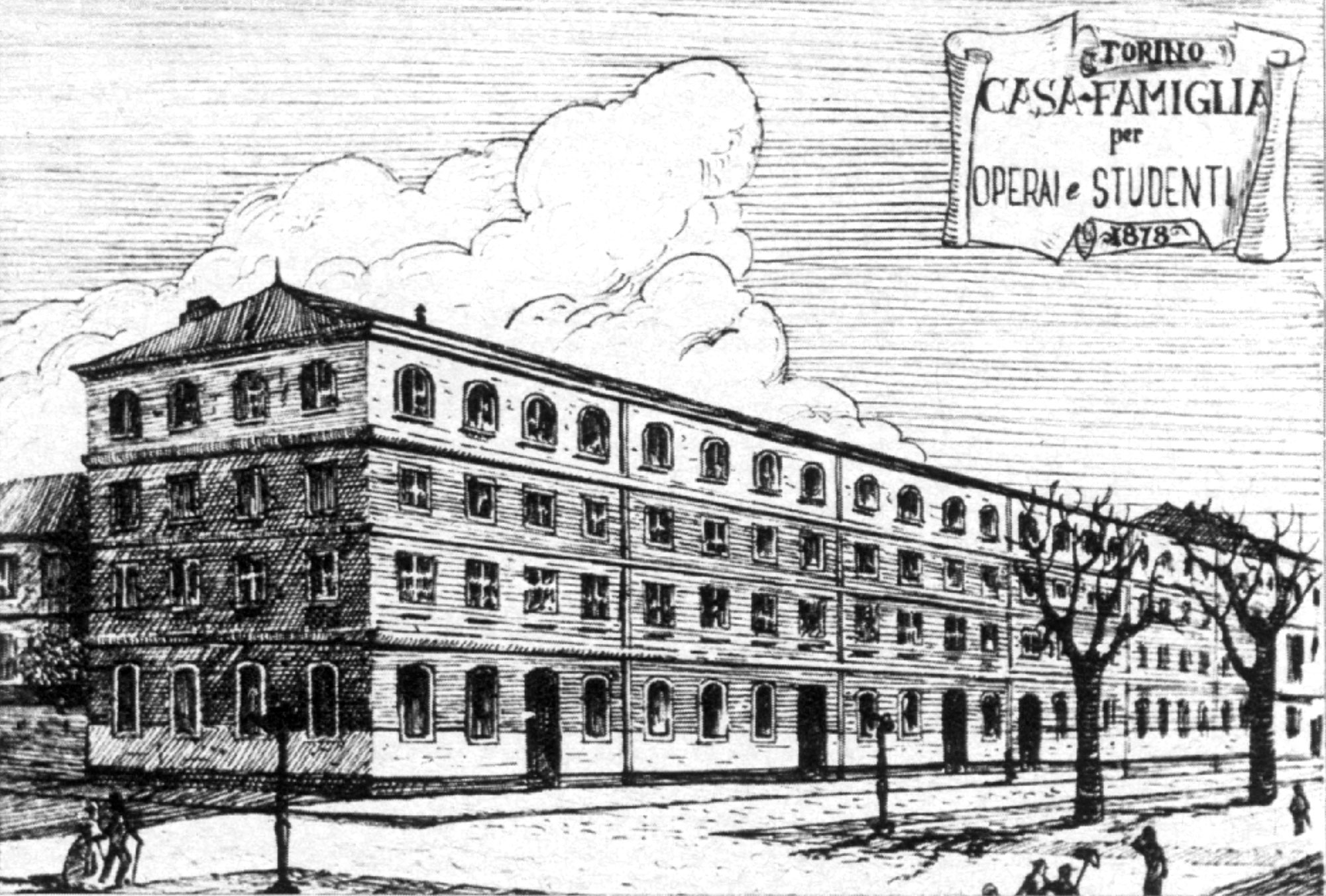
Si trovava di fianco alla chiesa di Santa Giulia. L’edificio sacro fu costruito in stile neogotico tra il 1863 e il 1866 con il determinante concorso finanziario della marchesa Giulia di Barolo. Il progetto fu dell’ing. Giovan Battista Ferrante, collaboratore del Murialdo all’Oratorio San Martino e insegnante di disegno al Collegio Artigianelli.
La Casa famiglia occupava il caseggiato a destra della chiesa (per chi guarda la facciata), più precisamente i numeri civici 4, 6, 8 di Piazza Santa Giulia, in angolo con via Balbo, sulla quale pure aveva alcuni ingressi. Nonostante le notevoli trasformazioni che subì in seguito, per essere adibito ad uso di abitazioni private e di uffici, l’edificio della Casa famiglia conserva ancora l’impronta conferitagli da colui che lo aveva progettato e costruito, l’ing. Carlo Peretti, nipote del Murialdo.
L’idea di una Casa famiglia per giovani operai venne al Murialdo durante i suoi frequenti viaggi in Francia. Egli pensò di portare questa istituzione anche in Italia, dove ancora non ne esisteva alcun esempio.
Con l’aiuto finanziario del nipote Carlo Peretti, il Murialdo affittò uno stabile di fianco alla chiesa di Santa Giulia ed aprì la Casa famiglia nel 1878. Negli anni seguenti l’edificio fu acquistato e progressivamente ingrandito.
La Casa famiglia era stata pensata anzitutto per i giovani che avevano finito la loro formazione professionale al Collegio Artigianelli. Ormai erano grandi e cominciavano a lavorare, ma non avevano una famiglia ed incontravano quindi gravi difficoltà per il vitto e per l’alloggio. La Casa famiglia era però aperta anche ad altri giovani lavoratori che venivano a Torino in cerca di occupazione.
Inoltre la Casa famiglia, vero e proprio pensionato per giovani operai, formava come il completamento e il coronamento di tutta l’organizzazione assistenziale facente capo al Collegio Artigianelli. A neanche un anno dall’apertura gli ospiti erano già venti e salirono ben presto a cinquanta. La Casa famiglia offriva loro vitto, alloggio in stanza singola e possibilità di svago per il tempo libero; provvedeva a far lavare, stirare e cucire la biancheria.
Il costo della pensione, nel 1886, era di 36 lire al mese. A quel tempo il salario mensile di un giovane operaio si aggirava sulle 55-65 lire. Pagata la pensione e fatta qualche spesa per l’abbigliamento, ogni giovane ospite della Casa famiglia poteva dunque mettere da parte un piccolo gruzzoletto per il suo futuro. Era un modo per avviare i giovani verso una vita indipendente e nello stesso tempo per continuare a star loro vicini, anche dal punto di vista formativo e religioso, nei primi difficili anni dell’inserimento nel mondo del lavoro.
Nel 1881 la Casa famiglia fu aperta anche agli studenti, per gli stessi motivi di carattere assistenziale, educativo e religioso. Ma la morte improvvisa (23 dicembre 1883) del “finanziatore” (Carlo Peretti, che aveva solo 38 anni) precipitò il Murialdo in una situazione economica molto grave, che si aggiungeva ai debiti già pesanti del Collegio Artigianelli.
Le difficoltà finanziarie resero travagliata la vita della Casa famiglia: quella per gli studenti fu in diverse riprese chiusa, riaperta, accorpata a quella degli operai.
Alcuni progetti non si poterono realizzare (quello di un dormitorio notturno, ad esempio), ma l’opera sopravvisse ancora, per alcuni decenni, fino al 1924.
Tomb of Murialdo Family
- Cimitero Generale Torino
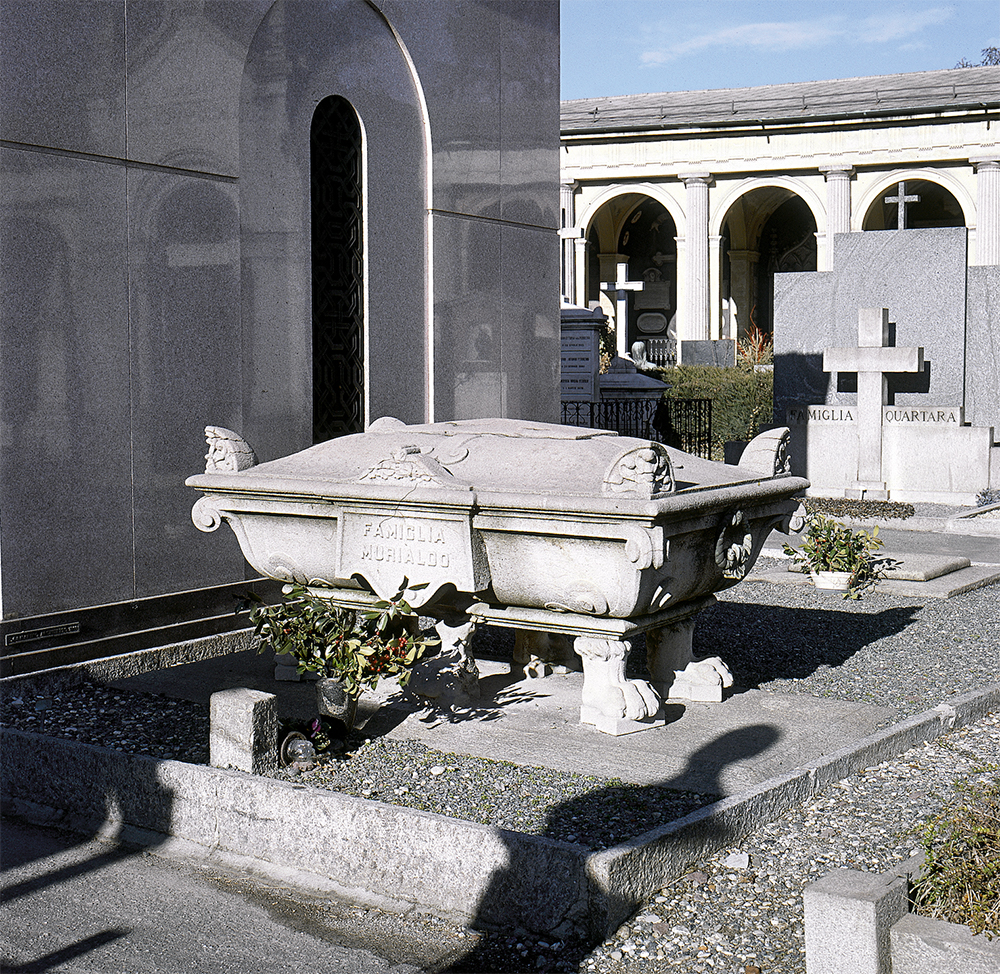
The Turin General Cemetery was built between 1828 and 1829 on land donated by the Marquise Giulia di Barolo, while the funding came from her husband, the Marquis Tancredi Falletti di Barolo, who was mayor of Turin and who contributed a sum of lire 300,000 (the municipality had allocated 10,000) .Subsequent extensions took place in 1841, 1866, 1883 and obviously also later.
After the funeral celebrated in the church of Santa Barbara (1 April 1900), Murialdo's body was buried in the family tomb of the General Cemetery of Turin (first extension, hemicycle, n. 133 bis).
Here it began to be a destination for visits by confreres and other people who had known Murialdo's sanctity, as Don Reffo recalls: "[...] a modest and gracious monument has been erected with an epigraph commemorating the foundation of the Pious Society [of St. Joseph]. Several of our confreres sometimes visit him, and go to those clods so dear to us to pray to him for the most urgent needs of the Congregation, and I dare to say never without fruit.
The Consolata Missionaries also went there once, and I remember with filial pride that that venerable man who is Canon Giuseppe Allamano said to that brave group of apostles: “One day this body will come out of this tomb to be venerated! May God make his word not a simple vow, but a true prophecy! ”».
The "modest and graceful monument" mentioned by Don Reffo was the aedicule supported by columns and shelves with the marble bust of Murialdo: the monument as a whole was designed by his brother Giovanni Massoglia, while the bust was sculpted by the sculptor Giuseppe Cerini. That monument and its tombstone then followed the remains of St. Leonard when they were transferred to Santa Barbara in 1917.
Also within the "first extension" there are other tombs of Murialdo's relatives. Here, however, we limit ourselves to indicating the plaque commemorating the mother of St. Leonard, Teresa Rho (1794-1849). The text was composed by Leonardo himself. The tomb is located in the basement, in correspondence with the tombstone.
Returning to the "primitive cemetery (the octagonal one), in the" south "part, field" C ", you can visit the tomb of the Congregation of San Giuseppe: a funeral chapel somehow imitating the Gothic style, with a marble portal and perimeter walls in exposed brick.
The Church of Our Lady Of Health
- Via Vibò, 24 – Torino
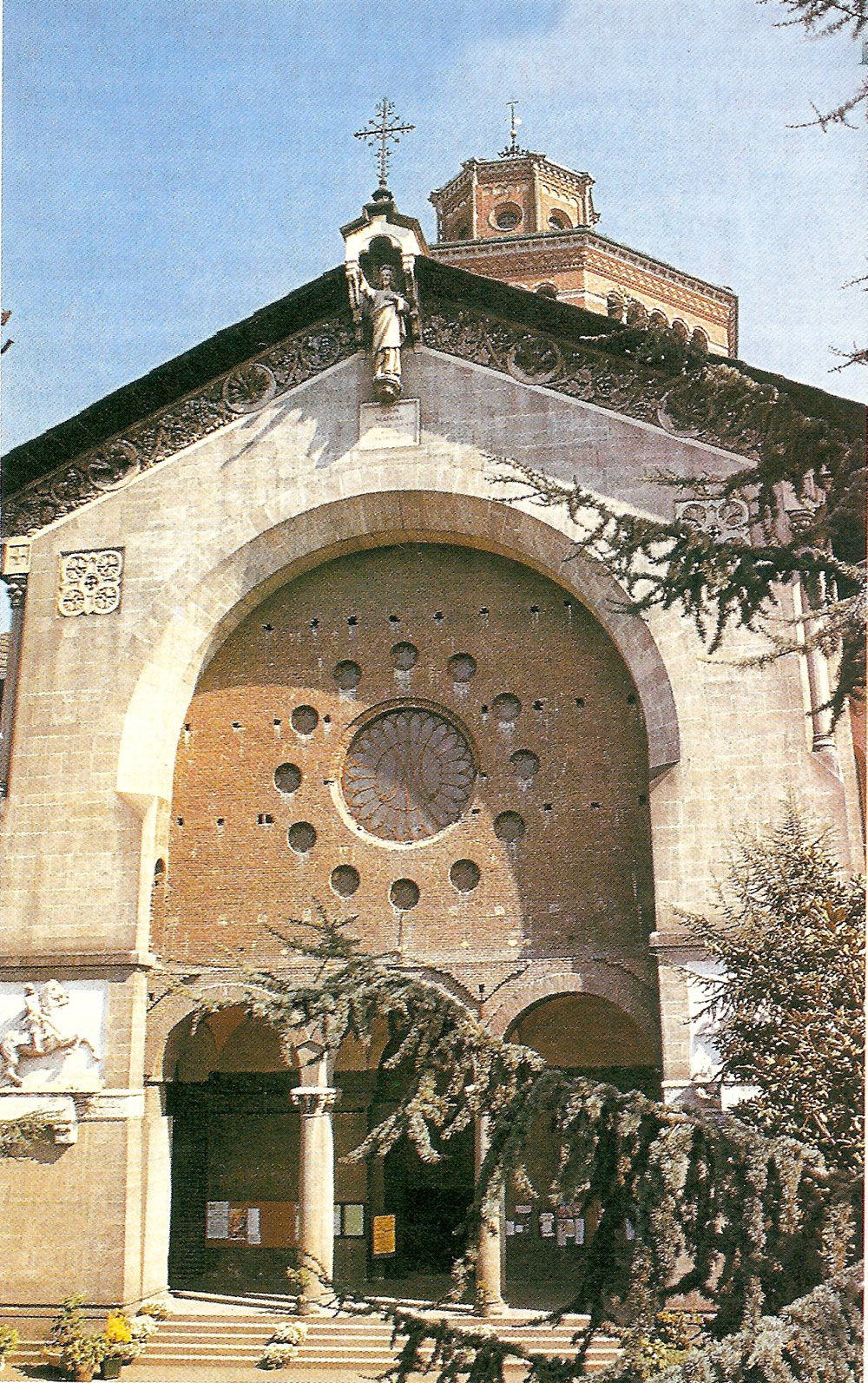
Il Borgo Vittoria, nel quale si trova il santuario, trae il suo nome dalla vittoria delle armi piemontesi e austriache contro i francesi durante l’assedio di Torino del 1706 (guerra di successione spagnola). L’assedio aveva seriamente minacciato la città tanto da indurre il duca Vittorio Amedeo II a promettere la costruzione di una chiesa alla Madonna sul colle di Superga in caso di liberazione (la Basilica di Superga è appunto l’adempimento di quel voto).
Terreno di battaglia era stata soprattutto la zona di Lucento e dell’attuale Borgo Vittoria. L’espansione della città in questa direzione divenne forte alla fine dell’Ottocento. Quando si trattò di costruirvi una chiesa, si pensò di intitolarla a Maria, “Salute”, cioè salvezza della patria. Ma si volle anche ricordarla come “salute degli infermi”, titolo sotto il quale era stata invocata durante il colera “asiatico” che nel 1835 aveva colpito Torino ed in particolare il vicino borgo del Balon (Porta Palazzo). Una nuova ondata di epidemia si era diffusa in Italia nel 1884, risparmiando però Torino e il nascente Borgo che avrebbe dovuto ospitare la nuova chiesa.
La congregazione dei Giuseppini era ben rappresentata nel comitato che si faceva promotore della costruzione. Vi facevano parte infatti il confratello laico Giovanni Massoglia, pittore, scultore e architetto, e don Reffo col pittore Enrico, suo fratello.
La costruzione del santuario andò avanti a fatica, tra difficoltà di ordine tecnico e soste imposte dalla mancanza di fondi. Il 15 giugno 1890 fu aperta una prima cappella provvisoria e cinque anni dopo, il 21 maggio 1895 si procedette alla posa della pietra fondamentale dell’imponente costruzione (il progetto era dell’ing. Angelo Reycend). Nel 1903 si poté aprire parzialmente al culto il nuovo edificio, ma il rettore della chiesa, monsignor Carlo Giaume morì nel 1929 senza veder completato il “suo” santuario. Aveva però fatto in tempo a cedere tutto il complesso, debiti inclusi, ai Giuseppini, che ne divennero proprietari nel 1927.
Con l’arrivo dei Giuseppini risorse anche l’oratorio, già aperto dal Giaume. Esso si chiamò “Oratorio San Martino” in ideale continuità con quello che dipendeva dal Collegio Artigianelli e che dal Borgo Dora era finito in Via Aosta n. 4 ed alla fine era stato venduto per pagare i debiti lasciati da monsignor Giaume.
Ripresero anche i lavori per il completamento del santuario. Nel 1934 la cupola era terminata. Nel 1937 fu inaugurato l’altare della Madonna. Al 1959 risalgono invece il nuovo altar maggiore e la sistemazione della Cripta dei Caduti.
Un cortiletto quadrangolare, circondato da portici, crea il giusto distacco tra l’animata vita del quartiere e il tempio mariano. Entrati nel quadriportico, si è davanti alla facciata del santuario. Un grande arco sovrasta il pronao poggiante su due colonne e quasi “custodito” dalle due statue equestri rappresentanti il duca di Savoia Vittorio Amedeo II ed il principe Eugenio di Savoia, suo cugino, comandante delle truppe imperiali che aiutarono il duca a liberare Torino dall’assedio del 1706.
Il vasto interno è sormontato da un’ampia e alta cupola. Immediatamente a sinistra, il primo ambiente custodisce una riproduzione fotografica della Sindone in grandezza naturale.
Proseguendo, si incontra il Trittico del Sacro Cuore, opera del pittore Enrico Reffo (1889). Al centro è rappresentato il Sacro Cuore di Gesù, a sinistra San Giuseppe, a destra l’Angelo Custode.
Mentre si entra nel transetto sinistro, si nota, sulla destra, un quadro di San Martino, vescovo di Tours. Questo dipinto (Reffo, 1868) era la pala d’altare della prima cappella dell’Oratorio San Martino.
In una nicchia del transetto sinistro è stata sistemata una statuina della Madonna. Risale ai tempi in cui si doveva ancora iniziare a costruire la chiesa. Fu collocata su un piccolo basamento, all’interno del terreno che avrebbe dovuto ospitare il futuro edificio sacro, e benedetta il 31 luglio 1887. Da allora i primi borghigiani cominciarono a venerarla con il titolo di Nostra Signora della Salute.
In fondo al transetto sinistro un ampio arco (notare, in alto, i due angeli del Reffo), immette alla scalinata che conduce all’altare di Nostra Signora della Salute. L’altare è opera dell’architetto Chioccarello, della Scuola Reffo (1937). Il quadro di Nostra Signora della Salute (1890) è di Enrico Reffo.
La cripta sottostante all’altare della Madonna custodisce le ossa dei caduti nella battaglia del 1706. Vi è sepolto anche mons. Giaume, fondatore del santuario.
L’altra parete del transetto ospita uno dei pilastrini, recanti l’immagine della Consolata, che il duca Vittorio Amedeo II aveva fatto collocare lungo le linee francesi due anni dopo la vittoria.
Il quadro di Federico Siffredi, rappresentante la Madonna, Causa nostrae laetitiae, con san Filippo Neri e san Martino, ornava l’altare della nuova chiesa dell’Oratorio San Martino, costruita tra il 1893 e il 1894.
All’architetto Chioccarello si deve anche l’altare principale (1959).
Nel transetto destro una lapide ricorda che anche San Leonardo Murialdo è legato ai primi inizi di questa chiesa. Il 2 marzo 1889 egli celebrava una messa all’altare della Consolata per «implorare la materna assistenza della Vergine sulla nuova impresa» della costruzione del santuario, tanto caldeggiata da alcuni suoi figli spirituali. Sul muro opposto un’altra lapide conserva la memoria del fondatore del santuario, mons. Carlo Giaume (1843-1929).
In fondo al transetto si giunge alla tomba di San Leonardo Murialdo. Le spoglie del Murialdo furono trasferite in questa chiesa il 6 giugno 1971, dopo essere rimaste per molti anni in quella di Santa Barbara.
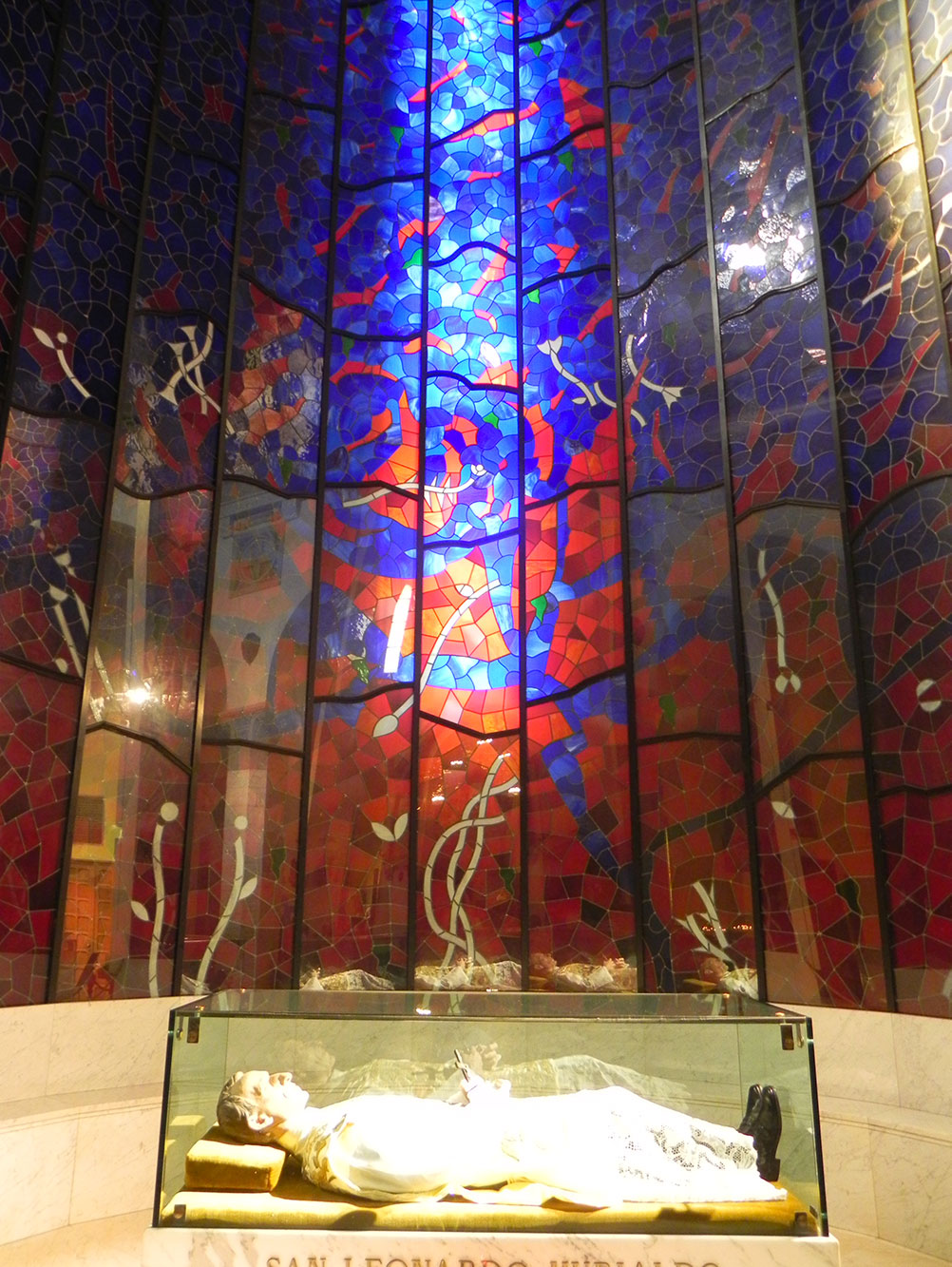
L’attuale sistemazione dell’urna fu inaugurata il 24 ottobre 1992. Il progetto è dovuto all’architetto torinese Giuseppe Giordanino. La vetrata policroma che fa da sfondo all’urna è del pittore marchigiano Oscar Piattella ed è stata realizzata dalle vetrerie GIBO di Verona. Il rosso, in basso, accoglie le spoglie di San Leonardo e poi ascende verso l’alto in piccoli frammenti, come un’espansione del suo amore e della sua risposta all’amore infinito e misericordioso di Dio. Attraverso una serie di blu più o meno profondi si sale alla calotta emisferica ricca di infiniti colori, dal verde luminoso allo splendore del giallo, quasi simbolo del divino che attrae l’amore umano (il movimento verso l’alto delle “fiammelle” rosse) e nello stesso tempo scende verso l’uomo (i “frammenti” verdi e anche gialli che “piovono” verso il basso) per ricolmarlo della sua grazia. Ai due lati della vetrata, alcuni pannelli del pittore torinese Luigi Togliatto Amateis illustrano la vita e le attività educative e sociali di san Leonardo Murialdo.
Il basamento dell’urna è disegnato a cerchi concentrici in marmo bianco appena ombreggiato e trasmette un senso di semplicità e di grande accessibilità. Il piano di appoggio che quasi continua il pavimento, il sedile circostante… tutto induce ad accostarsi. Vicino a San Leonardo Murialdo si può sostare con piacere e con familiarità. Davvero si gustano qui le belle parole che sul Murialdo ha pronunciato Paolo VI: «Non è un uomo lontano e difficile, non è un santo sequestrato dalla nostra conversazione; è un nostro fratello, è un nostro sacerdote, è un nostro compagno di viaggio. Il quale però, se davvero lo avviciniamo, non mancherà di provocare in noi quel senso di ammirazione dovuto alle anime grandi» (3 novembre 1963).
Il volto e le mani del Murialdo sono opera di Giovanni Gianese e Romolo Felici, entrambi romani. Essi si sono ispirati alle fotografie scattate a San Leonardo Murialdo sul letto che accoglieva la sua salma, poche ore dopo la morte. Il volto si apre ad un dolce sorriso che emana pace e serenità. Una mano stringe il crocifisso, l’altra accenna ad una leggera benedizione, segno di saluto ai suoi figli, ai ragazzi poveri ed abbandonati, a chi si ferma qui in preghiera.
Il dipinto che orna la parete sinistra del transetto è di Pietro Favaro (Scuola Reffo, 1963) e rappresenta il Murialdo ed il suo apostolato fra i giovani.
Sullo stesso lato, un bianco gruppo scultoreo di San Giuseppe Benedetto Cottolengo è dovuto ad Anacleto Barbieri (Scuola Reffo).
Un altro dipinto, sulla destra, ugualmente di Favaro (1968) raffigura il Murialdo nella gloria.
Addossata al pilastro del transetto destro c’è la tomba di don Eugenio Reffo (1843-1925), sacerdote giuseppino, primo collaboratore del Murialdo nella fondazione della congregazione, giornalista, scrittore, educatore e del quale è in corso la causa di beatificazione.
Più oltre, sulla sinistra, il quadro di San Giuseppe con Gesù adolescente e, sullo sfondo, il Santuario di Nostra Signora della Salute, è anch’esso dovuto al pennello di Favaro.
Avviandosi verso l’uscita si ha modo di osservare la facciata interna della chiesa, ornata dal Trittico degli Arcangeli, di Enrico Reffo (1914). Al centro è rappresentato l’Arcangelo Michele con la spada fiammeggiante e la scritta “Quis ut deus” (chi come Dio?) frase latina che ricorda il significato del suo nome nella lingua ebraica. A destra (per chi guarda), è l’Arcangelo Raffaele in atto di guidare il giovane Tobia. A sinistra Gabriele, l’Arcangelo dell’Annunciazione.
